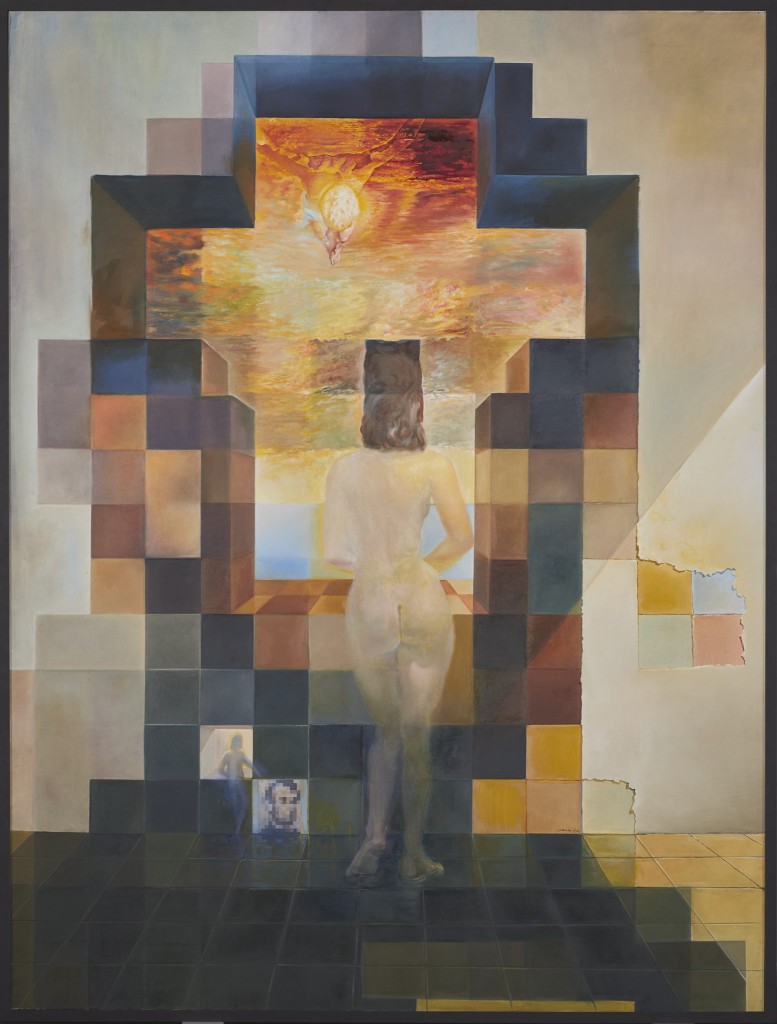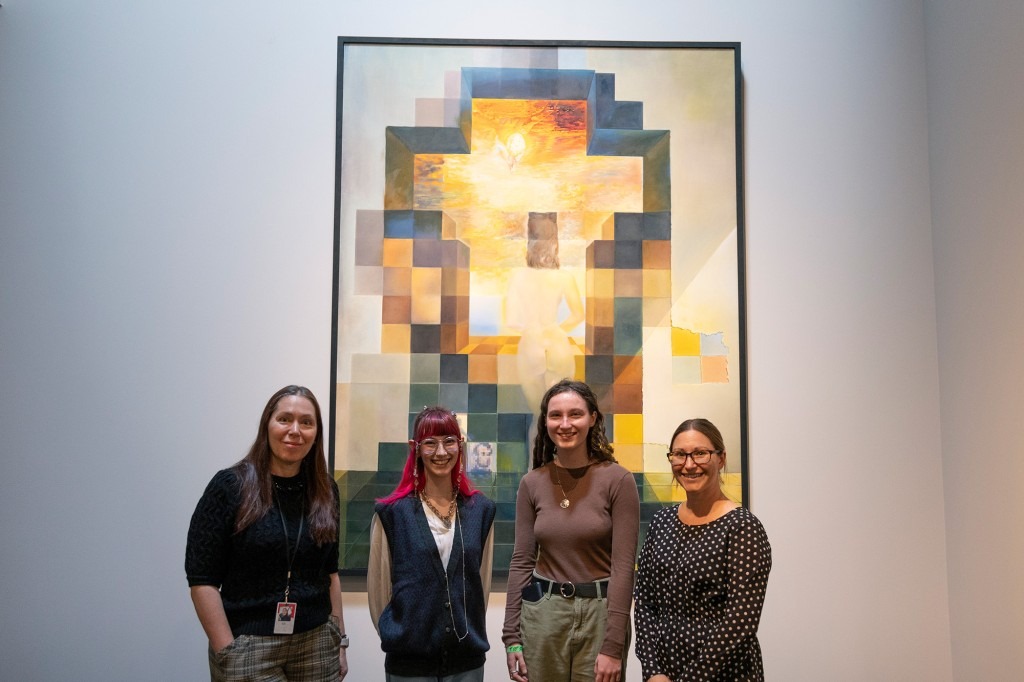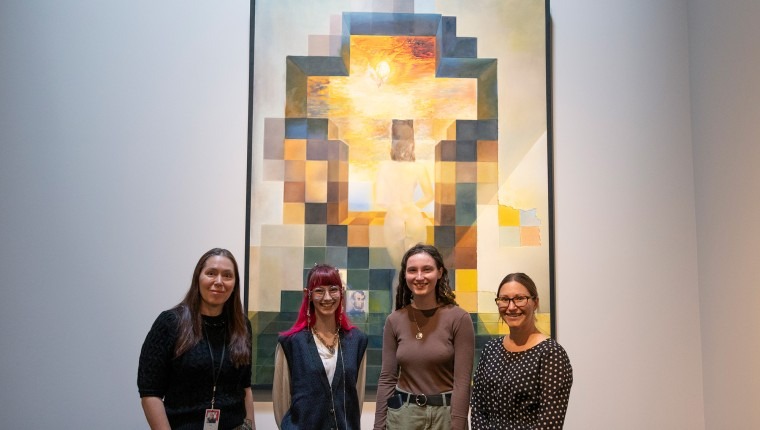to Helping Visually Impaired People
Perceive Salvador Dalí's Art
. . .
It seemed at first an impossible task—like photographing an idea. Describe a painting by surrealist artist Salvador Dalí to someone who is blind or visually impaired.
That was the challenge last fall when Cameron Hunt McNabb, Ph.D., an Eckerd College visiting assistant professor of literature, took her Disability and Literature class to The Dalí Museum in St. Petersburg.
Her students were studying disability aesthetics — the use of atypical bodies in art, literature and other fields. Few famous artists used atypical bodies more often, and more vividly, than Dalí.
But the students didn’t just look at the artwork. In a collaboration with the museum, the students were tasked with a service learning project – fill in missing components in the very detailed descriptions of the paintings and offer other suggestions for the multisensory kits intended for people who are blind or have low vision.
The kits also could contain sound or music to make the best attempt to capture what the painting is trying to convey.
Each student was assigned a Dalí masterwork.
One of McNabb’s students—Nora Colussy-Estes, a junior anthropology and literature student from Decatur GA — chose as their first attempt Dalí’s iconic Gala Contemplating the Mediterranean Sea which at Twenty Meters Becomes the Portrait of Abraham Lincoln-Homage to Rothko.
If a picture is worth a thousand words, then Gala Contemplating the Mediterranean is worth a million. From a few feet away, the oil-on-canvas painting, completed in 1976, depicts a woman framed by clouds and a figure of Jesus on the cross. But if the viewer moves about 20 yards away, the woman disappears and the face of Lincoln — straight off a five-dollar bill — comes clearly into focus.

“I wasn’t sure where to begin,” says Nora. “The title of the painting reveals the illusion, but how do I describe the painting itself? How do I describe perspective?
“I listened to the tapes about navigating the museum, and then I took pictures of sections of the painting and wrote simple descriptions of each one. Then I tried to combine the small descriptions into a story.
“And it helped. Dr. McNabb recommended moving one piece to another, and that helped even more. I wanted to do justice to the work, and I knew Dr. McNabb has the experience and knowledge to help me do that.”
Working on the project, Nora says, “made me realize how important it is to provide resources and access to something many of us take for granted. I hope I did an okay job.
“Personally, it gave me a more practical view of a world that is not made for me. It gave me this little sliver of experience that’s so important to discuss.”
The Smithsonian offers a thoughtful explanation of why visual description is needed in museums – and the challenge of describing artwhile letting listeners form their own opinions.
The collaboration between Eckerd College and the museum was more robust than most, says Kim Macuare, Ph.D., the Dalí’s Innovation Labs co-director and director of programming at the museum. “The idea had its origin in how we could provide experiences like a tour for guests who had vision impairments… how to pair the descriptions with the works, so the guests could imagine those works in a similar way a person could view them.
“We wanted the students to be part of the descriptions and think about what multisensory elements we could pair with the works that would enhance the engagement. This was a very unique project, but not an easy one. There is a very specific protocol to writing the descriptions.
“We’re getting ready to test it,” she adds. “To see what resonates and what works, and fine tune it. We’re using some of the ideas and descriptions the students came up with. We were glad we were able to connect with the College.”

McNabb also asked her students to write a reflection on the experience. “It [the service learning project] helps what students learn in the classroom stick and have an impact,” she explains. “It shows some of the real-world applications of what we’re learning and enables students to engage with the world in a more insightful way.”
McNabb is scheduled to offer the class again in the fall semester as a Reflective Service Learning course, where students can earn 20 service hours working at the Dalí on disability-related projects.
“I want students to learn about the various ways we can think about disability, in literature and in life, in order to better understand disabled experiences — including possibly one’s own experiences,” McNabb says.
“I also think that thinking about disability should be paired with some service or action of some kind – so the service component is very important to the overall goals of the course.”
Originally published in
the Eckerd College Newsroom
Explore Accessible Arts Pinellas Experiences
The St. Pete Arts Alliance hosts a visually-descriptive online audio tour of more than 100 murals painted between 2015-2021, including many no longer visible. The audio tour offers vivid descriptions of these monumental artworks and their impact on the landscape, in words voiced by Eugenie Bondurant. You can find text transcripts on the Arts Alliance website.
The Museum of Fine Arts and the Dalí Museum offer visitors who are color blind or have low color free color-enhancing EnChroma glasses to use as they explore the museum.
The Ringling Museum of Art in Sarasota offers an audio guide, large print brochures and the opportunity to request a tour that includes tactile objects and visual description.
The Dalí Museum App interfaces with personal Voice Over (iOS/Apple devices) and TalkBack (Android) devices with verbal description capabilities. Full-Page Magnifiers are available on request. You can find the details at thedali.org/visit/accessibility.





